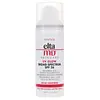What's inside
What's inside
 Key Ingredients
Key Ingredients

 Benefits
Benefits

 Concerns
Concerns

 Ingredients Side-by-side
Ingredients Side-by-side

Titanium Dioxide 11%
Cosmetic ColorantWater
Skin ConditioningIsododecane
EmollientC12-15 Alkyl Benzoate
AntimicrobialDimethicone
EmollientUndecane
EmollientTriethylhexanoin
MaskingIsohexadecane
EmollientStyrene/Acrylates Copolymer
Nylon-12
Caprylyl Methicone
Skin ConditioningButyloctyl Salicylate
Skin ConditioningPhenethyl Benzoate
EmollientSilica
AbrasiveTridecane
PerfumingDicaprylyl Carbonate
EmollientDicaprylyl Ether
EmollientTalc
AbrasiveAluminum Stearate
Cosmetic ColorantPentylene Glycol
Skin ConditioningC9-15 Fluoroalcohol Phosphate
Skin ConditioningTocopherol
AntioxidantPhenoxyethanol
PreservativeStearic Acid
CleansingDiethylhexyl Syringylidenemalonate
Skin ProtectingPEG-9 Polydimethylsiloxyethyl Dimethicone
EmulsifyingMagnesium Sulfate
PEG-8 Laurate
EmulsifyingPEG-9
HumectantPolyhydroxystearic Acid
EmulsifyingMaltodextrin
AbsorbentBenzoic Acid
MaskingIron Oxides
Propylene Glycol
HumectantPropylene Carbonate
SolventCaprylyl Glycol
EmollientDisteardimonium Hectorite
StabilisingCassia Alata Leaf Extract
AstringentAlumina
AbrasiveAluminum Hydroxide
EmollientTitanium Dioxide 11%, Water, Isododecane, C12-15 Alkyl Benzoate, Dimethicone, Undecane, Triethylhexanoin, Isohexadecane, Styrene/Acrylates Copolymer, Nylon-12, Caprylyl Methicone, Butyloctyl Salicylate, Phenethyl Benzoate, Silica, Tridecane, Dicaprylyl Carbonate, Dicaprylyl Ether, Talc, Aluminum Stearate, Pentylene Glycol, C9-15 Fluoroalcohol Phosphate, Tocopherol, Phenoxyethanol, Stearic Acid, Diethylhexyl Syringylidenemalonate, PEG-9 Polydimethylsiloxyethyl Dimethicone, Magnesium Sulfate, PEG-8 Laurate, PEG-9, Polyhydroxystearic Acid, Maltodextrin, Benzoic Acid, Iron Oxides, Propylene Glycol, Propylene Carbonate, Caprylyl Glycol, Disteardimonium Hectorite, Cassia Alata Leaf Extract, Alumina, Aluminum Hydroxide
Zinc Oxide 20.15%
Cosmetic ColorantWater
Skin ConditioningCoco-Caprylate/Caprate
EmollientNiacinamide
SmoothingIsopropyl Myristate
EmollientPolyglyceryl-3 Diisostearate
EmulsifyingEthyl Macadamiate
Skin ConditioningMica
Cosmetic ColorantGlycerin
HumectantPropanediol
SolventCetearyl Nonanoate
EmollientCapryloyl Glycerin/Sebacic Acid Copolymer
Skin ConditioningUndecane
EmollientCaprylic/Capric Triglyceride
MaskingTridecane
PerfumingPolyglyceryl-3 Polyricinoleate
EmulsifyingDisteardimonium Hectorite
StabilisingPhenoxyethanol
PreservativeOctyldodecyl Oleate
EmollientSodium Chloride
MaskingMagnesium Sulfate
Tocopheryl Acetate
AntioxidantIsostearic Acid
CleansingCocos Nucifera Fruit Extract
EmollientXanthan Gum
EmulsifyingBisabolol
MaskingSilica
AbrasiveSodium Hyaluronate
HumectantAloe Barbadensis Leaf Juice
Skin ConditioningLactic Acid
BufferingZingiber Officinale Root Extract
MaskingErgothioneine
AntioxidantIron Oxides
Zinc Oxide 20.15%, Water, Coco-Caprylate/Caprate, Niacinamide, Isopropyl Myristate, Polyglyceryl-3 Diisostearate, Ethyl Macadamiate, Mica, Glycerin, Propanediol, Cetearyl Nonanoate, Capryloyl Glycerin/Sebacic Acid Copolymer, Undecane, Caprylic/Capric Triglyceride, Tridecane, Polyglyceryl-3 Polyricinoleate, Disteardimonium Hectorite, Phenoxyethanol, Octyldodecyl Oleate, Sodium Chloride, Magnesium Sulfate, Tocopheryl Acetate, Isostearic Acid, Cocos Nucifera Fruit Extract, Xanthan Gum, Bisabolol, Silica, Sodium Hyaluronate, Aloe Barbadensis Leaf Juice, Lactic Acid, Zingiber Officinale Root Extract, Ergothioneine, Iron Oxides
 Reviews
Reviews

Ingredients Explained
These ingredients are found in both products.
Ingredients higher up in an ingredient list are typically present in a larger amount.
Disteardimonium Hectorite comes from the clay mineral named hectorite. It is used to add thickness to a product.
It can also help stabilize a product by helping to disperse other ingredients.
Hectorite is a rare, white clay mineral.
Learn more about Disteardimonium HectoriteMagnesium Sulfate is a salt. More specifically, it is an epsom salt, or the bath salt used to help relieve muscle aches.
Despite having ‘sulfate’ in the name, it isn’t a surfactant or cleansing agent like sodium lauryl sulfate. Unlike those sulfates, magnesium sulfate doesn’t have the same cleansing or foaming properties (it's simply a type of salt).
In cosmetics, Magnesium Sulfate is used to thicken a product or help dilute other solids. It is a non-reactive and non-irritating ingredient.
One study shows magnesium deficiency may lead to inflammation of the skin. Applying magnesium topically may help reduce inflammation.
You can find this ingredient in sea water or mineral deposits.
Learn more about Magnesium SulfatePhenoxyethanol is a preservative that has germicide, antimicrobial, and aromatic properties. Studies show that phenoxyethanol can prevent microbial growth. By itself, it has a scent that is similar to that of a rose.
It's often used in formulations along with Caprylyl Glycol to preserve the shelf life of products.
Silica, also known as silicon dioxide, is a naturally occurring mineral. It is used as a fine, spherical, and porous powder in cosmetics.
Though it has exfoliant properties, the function of silica varies depending on the product.
The unique structure of silica enhances the spreadability and adds smoothness, making it a great texture enhancer.
It is also used as an active carrier, emulsifier, and mattifier due to its ability to absorb excess oil.
In some products, tiny microneedles called spicules are made from silica or hydrolyzed sponge. When you rub them in, they lightly polish away dead skin layers and enhance the penetration of active ingredients.
Learn more about SilicaTridecane is a lightweight emollient and fragrancing ingredient. It is a paraffin and often called a silicone alternative.
According to official INCI guidelines, this ingredient is used to give a light odor to raw materials. It is often used as a starter ingredient to create parfum.
This ingredient can be derived from palm oil, or coconut oil. It is also naturally found in certain species of organisms.
According to the NOAA, this ingredient can cause skin sensitivity with prolonged use. However, this warning is taken from the Coast Guard and no studies have been done on this in relation to cosmetics.
Tridecane is not water soluble.
Learn more about TridecaneUndecane is an emollient and helps create a lightweight base for products.
Is is not soluble in water and naturally occurring in some species.
Water. It's the most common cosmetic ingredient of all. You'll usually see it at the top of ingredient lists, meaning that it makes up the largest part of the product.
So why is it so popular? Water most often acts as a solvent - this means that it helps dissolve other ingredients into the formulation.
You'll also recognize water as that liquid we all need to stay alive. If you see this, drink a glass of water. Stay hydrated!
Learn more about WaterThis ingredient is a combination of red, black, and yellow iron oxide pigments. This combination of colors is usually found in foundation, because it results in a "skin" color.